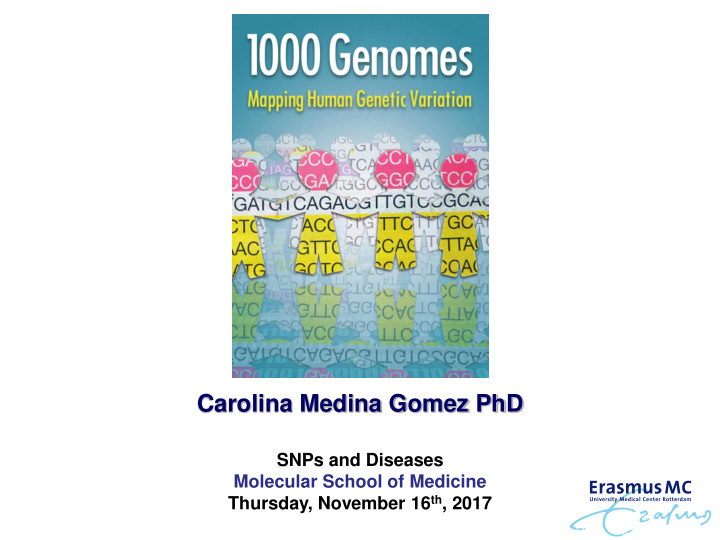



Carolina Medina Gomez PhD SNPs and Diseases Molecular School of Medicine Thursday, November 16 th , 2017
Topic outline - Quick look to the pioneers: HapMap - 1000 Genomes project -Description - Diversity Panel -The HRC consortium - Local Panels Learning Aims - Acquire awareness on the implications of population diversity - Comprehend the utility of large haplotype reference panels and large biobank data - Use this knowledge for the mapping of complex traits
The HapMap Project AIM Perform a comprehensive sampling of common genetic variation that may form the basis of phenotypic differences in humans CEU CHB+JPT YRI A second generation human haplotype map of over 3.1 million SNPs 2007, Nature 449: 851-861.
The HapMap Project HapMap II r 22: Build 36 - 2007 270 samples CEU CHB+JPT YRI
HapMap III r22 Build 36 - 2010 1,184 Samples – DEPICT, LDSC Name Population # of samples ASW African ancestry in Southwest USA 53 Utah residents with Northern and Western European ancestry CEU 112 from the CEPH collection CHB Han Chinese in Beijing, China 137 CHD Chinese in Metropolitan Denver, Colorado 109 GIH Gujarati Indians in Houston, Texas 101 JPT Japanese in Tokyo, Japan 113 LWK Luhya in Webuye, Kenya 110 MEX Mexican ancestry in Los Angeles, California 58 MKK Maasai in Kinyawa, Kenya 156 TSI Toscani in Italia 102 YRI Yoruba in Ibadan, Nigeria 147 Integrating common and rare genetic variation in diverse populations 2010, Nature 467: 52-58.
The 1000 Genomes project – Build 37 Phase 1 – 2010 AIM Catalogue of human genetic variation sequencing whole genome of 1,092 individuals from 14 worldwide populations. Discover human genetic variations of all types (95% of variation > 1% frequency) at the population level The 1000 Genomes Project Consortium 2010, Nature 467: 1061-1073.
The 1000 Genomes project – Build 37 Phase 3 – 2015 AIM Catalogue of human genetic variation sequencing whole genome of 2,504 individuals from 14 worldwide populations. Discover human genetic variations of all types (99% of variation > 1% frequency) at the population level A global reference for human genetic variation 2015, Nature 526: 68-.
The 1000 Genomes project – Build 37 Phase 3 – 2014 AIM Catalogue of human genetic variation sequencing whole genome of 2,504 individuals from 14 worldwide populations. Discover human genetic variations of all types (99% of variation > 1% frequency) at the population level A global reference for human genetic variation 2015, Nature 526: 68-.
The American Journal of Human Genetics 96, 37 – 53, January 8, 2015
2012 Phased design Generation R HapMap Imputation 3,021,329 SNPs 2,671,724 MAF>0.01 r 2 >=0.3 2017 Generation R 1KG Imputation 47,072,644 SNPs 11,361,791 MAF>0.01 r 2 >=0.3
None of the two variants were present or tagged by HapMap variants (one is common)
Imputation Servers
The Haplotype reference consortium – Build 37 Phase 1 – 2016 AIM To bring together as many whole-genome sequencing data sets as possible. This reference panel consists of 64,976 haplotypes at 39,235,157 SNPs. A reference panel of 64,976 haplotypes for genotype imputation. Nature Genetics 48 10
The Haplotype reference consortium – Build 37 Phase 1 – 2016 AIM To bring together as many whole-genome sequencing data sets as possible. This reference panel consists of 64,976 haplotypes at 39,235,157 SNPs. 34% increase r 2 at 0.1% r 2 at ~0.4% A reference panel of 64,976 haplotypes for genotype imputation. Nature Genetics 48 10
http://www.nealelab.is/blog/2017/7/19/rapid-gwas-of-thousands-of-phenotypes-for-337000-samples-in- the-uk-biobank
The Million Veteran Program began collecting data in 2011, and it has the goal of reaching 1 million participants by 2020 or 2021. Now … imagine if we combine data Predictions for next GIANT freeze 1.5 million
Analytical Issues!
Current challenges Perception challenge: Are we using the correct multiple testing threshold, or we should change it as we are including more rare variants constituting independent test (LD low). Methodological challenge: Is it necessary to correct further for population stratification (implementation of mixed model) to avoid false-positive signals. Computational challenge: Can we store and analyze the data with our current computational power. Follow-up challenge Can we identify correctly variants/genes for follow-up studies.
The discovery of genetic variants associated with a trait or disease is determine by different parameters
The new GWAS era is a treasure trove for making new fundamental discoveries in human genetics. New imputation panels allow to explore variants with MAF ~0.1% More variants more opportunities We are surpassing the 1M barrier to tag the causal variant 10 Years of GWAS Discovery: Biology, Function, and Translation. AJHG July. 2017
Resolution magnification P<=6.6x10 -9 Identification of 153 new loci associated with heel bone mineral density and functional involvement of GPC6 in osteoporosis. Nature Genetics .
Original 2x2 scenario of genetic architecture needs to be redefined under the scope of the 1000G and other projects
Debatable Facts
Take home messages - Understanding of human genome diversity is key for the design of genetic studies - Large and more comprehensive panels panels provide the best performance and yield in terms of quality and MAF coverage resulting in greater power (even more so, in combination with MegaBiobanks!) - Most of the novel variants to be discovered are of “low to rare” allele frequency, highly population specific & enriched for functional aspects - Upscaling of technology, either through interfacing with -omic data or through experimental perturbations are necessary for making new fundamental discoveries in human genetics
10 Years of GWAS Discovery: Biology, Function, and Translation. AJHG July. 2017
Recommend
More recommend